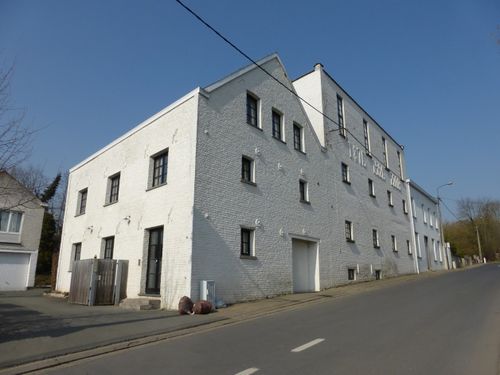Eylenbosch (Huizingen): Difference between revisions
m →History |
m →History |
||
| (17 intermediate revisions by the same user not shown) | |||
| Line 4: | Line 4: | ||
==History== | ==History== | ||
Brouwerij Eylenbosch existed from 1895-1965, | Brouwerij Eylenbosch existed from 1895-1965, and produced gueuze and lambic. It was located in Huizingen at [https://goo.gl/maps/RKZg3HRak91VuB5JA Sollenberg 7-15.] | ||
Previously the Cammaert brewery existed here from 1864-1895. Cammaert's great-granddaughter Anna Maria married Martinus Josephus Eylenbosch in 1874, and he later took over brewery operations from Joannes-Baptista Wynants-Cammaert in 1895. Eylenbosch passed away in 1922, leaving the brewery to his sons Jan-Baptist and Georges. | |||
In 1948, the brewery transferred ownership again to Jan-Baptist's son Henri when Jan-Baptist passed away that year. During this time, the brewery was modernized, and Gueuze was packaged in 25cl bottles with crown caps. Production continued until 1965. The buildings were converted to residential lofts from 2006–2008 by architect Steven Winderickx, son of lambic brewer Edgar Winderickx. Source: Brouwerijen en Bierstekerijen en Beersel. Delplancq, p. 292. <ref name=Delplancq1> | |||
[https://www.lambic.info/Les_Brasseurs_du_Lambic:_Données_Historiques_et_Géographiques. Delplancq, Thierry. Les Brasseries de Lambic, Données Historiques et Géographiques (XVIIIe-XXe s.), Archives et Bibliothèques de Belgique: n° 67, 1996.]</ref> <ref name=Eylenbosch2>[https://translate.google.com/translate?sl=auto&tl=en&js=y&prev=_t&hl=en&ie=UTF-8&u=https%3A%2F%2Finventaris.onroerenderfgoed.be%2Ferfgoedobjecten%2F303150&edit-text= Architectural history page.]</ref> <ref name=Eylenbosch3>[https://www.routeyou.com/nl-be/location/view/49346476/brouwerij-eylenbosch History timeline page. ]</ref> <ref name=Eylenbosch4>[https://gw.geneanet.org/durseno?lang=en&m=P&v=anna+maria&edit-text= Genealogy page.]</ref> | |||
==21st Century Revival== | |||
In 2020, a descendant of the Eylenbosch family began a revival of Eylenbosch as a lambic blender on the adjacent farm property. The farm grows wheat, Pajotse barley, and Belgian hops to be used in brewing lambic. Oude Kriek will be made with locally harvested Schaerbeek cherries. The new blendery is named [[Het_Boerenerf|Het Boernerf.]] <ref name=Eylenbosch5>[https://www.eylenbosch.bio/lambiek-eylenbosch Boerderij Eylenbosch website]</ref> | |||
==Breweriana== | ==Breweriana== | ||
<gallery> | <gallery> | ||
File: | File:EylenboschHuizingensign.jpeg|Cardboard sign, date unknown. Source: 2dehands.be | ||
File:EylenboschHuizingenbottle.jpg|Silkscreened bottle label, date presumed 1948-1965. Source: 2dehands.be | |||
File:EylenboschHuizingenglass.jpg|Silkscreened glass, date unknown. Source: 2dehands.be | |||
</gallery> | </gallery> | ||
Latest revision as of 15:03, 29 January 2023
←List of Closed Lambic Breweries and Blenders

History
Brouwerij Eylenbosch existed from 1895-1965, and produced gueuze and lambic. It was located in Huizingen at Sollenberg 7-15.
Previously the Cammaert brewery existed here from 1864-1895. Cammaert's great-granddaughter Anna Maria married Martinus Josephus Eylenbosch in 1874, and he later took over brewery operations from Joannes-Baptista Wynants-Cammaert in 1895. Eylenbosch passed away in 1922, leaving the brewery to his sons Jan-Baptist and Georges.
In 1948, the brewery transferred ownership again to Jan-Baptist's son Henri when Jan-Baptist passed away that year. During this time, the brewery was modernized, and Gueuze was packaged in 25cl bottles with crown caps. Production continued until 1965. The buildings were converted to residential lofts from 2006–2008 by architect Steven Winderickx, son of lambic brewer Edgar Winderickx. Source: Brouwerijen en Bierstekerijen en Beersel. Delplancq, p. 292. [1] [2] [3] [4]
21st Century Revival
In 2020, a descendant of the Eylenbosch family began a revival of Eylenbosch as a lambic blender on the adjacent farm property. The farm grows wheat, Pajotse barley, and Belgian hops to be used in brewing lambic. Oude Kriek will be made with locally harvested Schaerbeek cherries. The new blendery is named Het Boernerf. [5]
Breweriana
-
Cardboard sign, date unknown. Source: 2dehands.be
-
Silkscreened bottle label, date presumed 1948-1965. Source: 2dehands.be
-
Silkscreened glass, date unknown. Source: 2dehands.be


